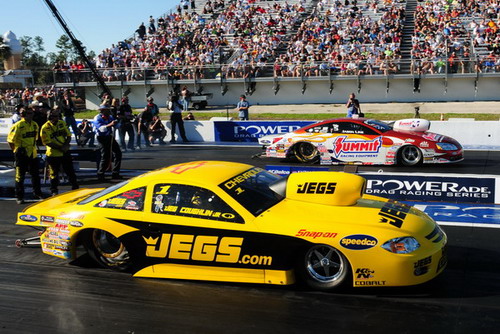600-INCH PRO STOCK REVISITED
The topic has not even reached the NHRA’s radar screen, but a month ago, Torco’s CompetitionPlus.com asked multi-time champion Greg Anderson what would he feel about increasing the cubic inch for the NHRA’s Pro Stock division.
Anderson admitted a cubic inch increase would be great for the NHRA's Pro Stock class. Virtually every other one of his opponents said the move would the final nail in the coffin for their racing efforts.
Torco’s CompetitionPlus.com discussed the idea with several teams in the wake of the real possibility IHRA’s Pro Stockers will soon dip into the 6-teens, leaving the five-second zone on the not-so-distant horizon. The consensus was the extreme cost would never be justified by the meager amount of publicity and performance gains they'd achieve.
The performance gains would be substantial; The cost would be devastating to many ...

The topic has not even reached the NHRA’s radar screen, but a month ago, Torco’s CompetitionPlus.com asked multi-time champion Greg Anderson what would he feel about increasing the cubic inch for the NHRA’s Pro Stock division.
Anderson admitted a cubic inch increase would be great for the NHRA's Pro Stock class. Virtually every other one of his opponents said the move would the final nail in the coffin for their racing efforts.
Torco’s CompetitionPlus.com discussed the idea with several teams in the wake of the real possibility IHRA’s Pro Stockers will soon dip into the 6-teens, leaving the five-second zone on the not-so-distant horizon. The consensus was the extreme cost would never be justified by the meager amount of publicity and performance gains they'd achieve.
“It would be terrible for a small team like us,” said Terry Adams, crew chief for Mike Edwards. ‘You might shake things up for a little while but the ones who are on top now will get back there. In three years, you’d be right back where you started from.”
In 1982, the NHRA changed their Pro Stock format drastically. The sanctioning body adopted a 500-inch universal displacement replacing the pounds-per-cubic inch format. This notice was delivered just days after the 1981 NHRA World Finals at Orange County International Raceway in California.
If you would raise the money available, we’d entertain the idea of raising the cubic inch limit. All of a sudden, we’d have all of this 500-inch data that we scraped and fought to learn that would become obsolete. I think such a move would push those teams sitting on the fence over the edge. - Lisa Edwards, wife of Pro Stock racer Mike Edwards
That’s why seven-time NHRA Pro Stock champion Bob Glidden could relate to the hardship experienced by the lesser financed teams if such a move were pondered.
“The whole scenario was tough for us because we didn’t have any 500-inch engines whatsoever,” Glidden said. “That was the reason that most of the GM guys wanted the rules changed.”
The horsepower increase would be upwards of 400 horsepower which would easily put the NHRA teams into the low 6.30s and high 6.20s.
“You’d need new crankshaft and a lot of new parts,” Kurt Johnson added. “The cost of competing would go up.”
Would the excitement the larger engines create exceed that always exerted by the current combination?
“You’d see the big numbers come up on the scoreboard and while that would be exciting for the fans, it would a financial back breaker for some of the teams,” said Johnson.
With today’s Pro Stock clearly playing second-fiddle to the nitro divisions, would the publicity play out in today’s media environment comparable to the way 1982 transpired? At least three major automotive publications featured the new look seven-second Pro Stockers on their printed pages.
Super Stock and Drag Illustrated Magazine, the clearly defined leader in drag racing publications of the day, devoted ten editorial pages to the new format. The large conclusion is today’s drag racing media, in this day and age just doesn’t have the impact those early journals provided.
“If you would raise the money available, we’d entertain the idea of raising the cubic inch limit,” said Lisa Edwards, whose husband Mike Edwards is a 500-inch racer who recently opened his in-house engine program. “All of a sudden, we’d have all of this 500-inch data that we scraped and fought to learn that would become obsolete. I think such a move would push those teams sitting on the fence over the edge.
“But, then again, we’re spending so much to just keep up already, that we’d more than likely we’d find a way to make it happen.”




































